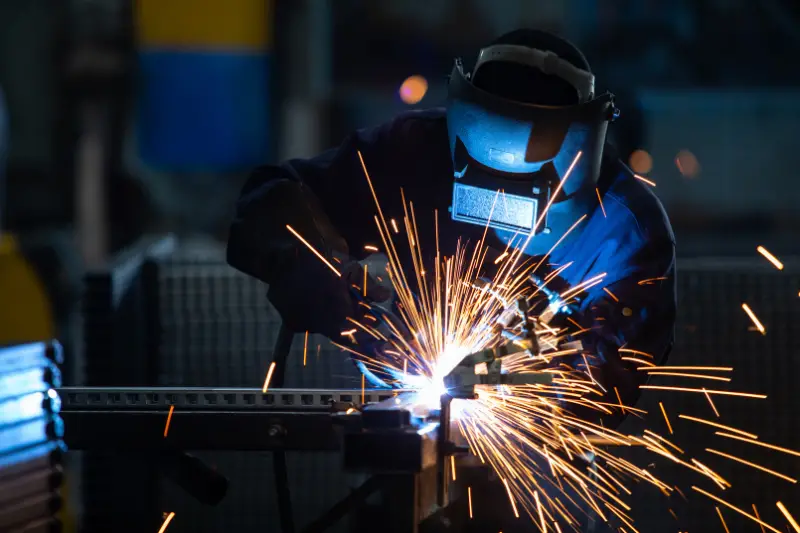Click here to get this post in PDF
Many people confuse the terms “welding” and “fabrication,” with most using them interchangeably. But these two terms mean completely different things. In a nutshell, metal fabrication is the process of creating a metal product, while welding is the process of joining together different pieces of metal, glass, or even plastics using fusion techniques. You might have seen the process of welding near you as we often see the welders doing their jobs in homes, offices, schools etc. However, considering this industry’s ever-evolving nature, it’s possible that welders can perform fabrications too.
Welding is a metal shaping method, but it goes hand in hand with sheet metal fabrication, and both occupations use identical methods to get the finished product, such as assembling and bending. Both methods are important and used across many industries, from construction to automotive manufacturer to transportation. Before we move ahead, we would suggest you to visit this page to find the best welding schools as there are hundreds of welding schools across the nation and finding the best one can give you a hard time.
There are many techniques used in welding today, visit site for equipment. These include oxy-acetylene, Tungsten Inert Gas (TIG) (the most popular in fab shops), and gas metal arc (GMAW) among others. However, since metal fabrication is the main process, it involves various specialty techniques such as die-cutting, stamping, roll forming, spinning, finishing, hydroforming, and stretching, just to mention but a few.
Some tools used in metal fabrication include:
- A 4 ½-inch or 6-inch angle grinder: Used to cut, grind and polish metal pieces.
- Angle grinder discs: Includes grinding wheels, flap discs, cutoff wheels, and wire wheels.
- Wire cutters: Used to snip frayed ends of the metal.
- Angle finders: Mostly made of steel or aluminum
- Drill bits: Especially useful for sheet metal fabricators
- A throat-less shear: Used to achieve curved, irregular, or straight cuts on metal
Some tools used in welding include:
- Chipping hammers
- Benders
- Electrode holders
- Tungsten inert gas (TIG) consumables
- Hand file
- Welding Clamps and abrasives, among others.
Both welding and metal fabrications are also similar in some aspects. Both jobs necessitate the use of cleaning equipment and material in order to disinfect the metal. To clean out grease, sticky stains, and germs, professionals use a wire brush and an organic cleaner, such as acetone or a gentle alkaline solution, or a citrus-based degreaser without butoxyethanol (a chemical agent that may induce respiratory and liver problems).
Welders and fabricators alike use regular mops and sweepers to disinfect the plant following a long day of operation. Industry-specific cleaning techniques such as Surface safety films, floor finishes and coatings, and electro-cleaners are also commonly utilized by these professionals.
Safety precautions in welding and fabrication processes
Since dealing with hot metal and heavy machinery makes this industry riskier than most, both welders and sheet metal fabricators should be mindful of the protection guidelines in their respective workshops. In this case, protective equipment should be a priority. These include:
- Thick leather work gloves
- Safety goggles
- Respiratory/dust mask
- Leather coveralls
- Well-fitting flame resistant jackets
- Non-slip of steel toe boots
To ensure safety, metal fabrication and welding facilities should have strict equipment storage regulations, and every worker must be trained on how to use the machinery safely on their own. Also, regular inspection of tools may come in handy to ensure faulty ones that may pose a danger to workers are identifies, repaired, or halted from use.
Quality Inspections
When it comes to welding inspection, it’s crucial for welding equipment to adhere to the specification prepared by a qualified and experienced engineer. The engineer specifies the welding method, size of the weld, filler rod material, and the number of passes, as well as the inspection techniques.
In metal fabrication, the process is also inspected and approved by an engineer or quality inspector, which is crucial in a metal fabrication business. In the past, radiographic inspection was used in quality control. Nowadays, ultrasonic inspection is used, including pulse echo techniques to ensure the accuracy of inspection.
Hiring A Professional
Now that you’ve learned the differences and similarities of metal fabrication and welding, you might want to consider hiring a professional to ensure high-quality output for your project.
You can work with an expert in manufacturing, metal fabrication, and laser cutting such as Kanyana Engineering Perth that employs the right people and state-of-the-art technology. Dealing with a professional with years of experience can deliver exceptional results within your budget.
In Conclusion
You’ve just learned the key differences and similarities between welding and metal fabrication. Generally, fabrication involves the process of creating a project using metal, whereas welding is a single operation during the metal fabrication process. Metal fabrication evolves, from design and layout to product formation and finishing.
You may also like: How You Can Start a Metal Fabrication Business
Image source: stock.adobe.com

